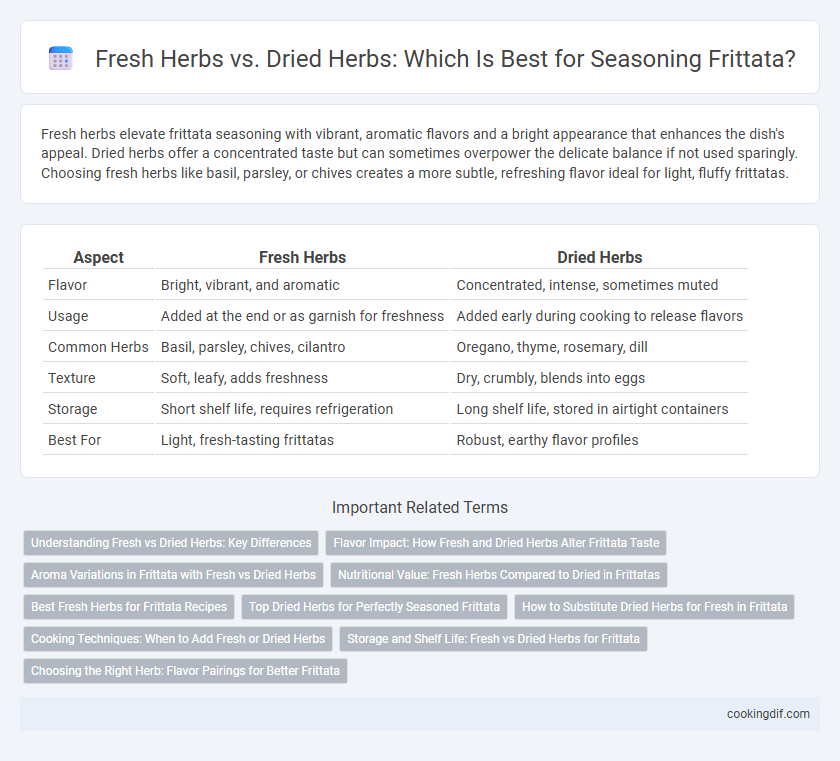Fresh herbs elevate frittata seasoning with vibrant, aromatic flavors and a bright appearance that enhances the dish's appeal. Dried herbs offer a concentrated taste but can sometimes overpower the delicate balance if not used sparingly. Choosing fresh herbs like basil, parsley, or chives creates a more subtle, refreshing flavor ideal for light, fluffy frittatas.
Table of Comparison
| Aspect | Fresh Herbs | Dried Herbs |
|---|---|---|
| Flavor | Bright, vibrant, and aromatic | Concentrated, intense, sometimes muted |
| Usage | Added at the end or as garnish for freshness | Added early during cooking to release flavors |
| Common Herbs | Basil, parsley, chives, cilantro | Oregano, thyme, rosemary, dill |
| Texture | Soft, leafy, adds freshness | Dry, crumbly, blends into eggs |
| Storage | Short shelf life, requires refrigeration | Long shelf life, stored in airtight containers |
| Best For | Light, fresh-tasting frittatas | Robust, earthy flavor profiles |
Understanding Fresh vs Dried Herbs: Key Differences
Fresh herbs offer vibrant flavor and aroma to a frittata, releasing essential oils that enhance taste immediately upon cooking. Dried herbs provide a more concentrated, intense flavor that develops slowly, making them ideal for longer cooking times but requiring careful measurement to avoid overpowering. Adjusting quantities and considering cooking duration are crucial for balancing fresh and dried herbs to achieve optimal seasoning in a frittata.
Flavor Impact: How Fresh and Dried Herbs Alter Frittata Taste
Fresh herbs like basil, parsley, and chives impart vibrant, bright flavors to frittatas, enhancing the dish with a delicate aroma and subtle freshness. Dried herbs such as oregano, thyme, and rosemary offer a more concentrated, robust taste that intensifies during cooking, often resulting in a deeper, earthier flavor profile. Choosing between fresh and dried herbs directly influences the frittata's overall flavor complexity, with fresh herbs providing light, fragrant notes and dried herbs delivering bold, intensified seasoning.
Aroma Variations in Frittata with Fresh vs Dried Herbs
Fresh herbs in frittata seasoning impart a vibrant, bright aroma that enhances the overall freshness of the dish, releasing essential oils more readily during cooking. Dried herbs offer a more concentrated, intense scent but can sometimes provide a slightly bitter or muted aromatic profile due to their desiccation process. The choice between fresh and dried herbs significantly influences the frittata's aromatic complexity, with fresh herbs delivering a lighter, greener fragrance while dried herbs contribute deeper, earthier notes.
Nutritional Value: Fresh Herbs Compared to Dried in Frittatas
Fresh herbs in frittatas retain higher levels of vitamins A, C, and K, contributing essential antioxidants and enhancing nutritional value compared to dried herbs. While dried herbs offer concentrated flavor, they often lose some delicate nutrients during processing and storage. Incorporating fresh herbs maximizes both taste and health benefits, providing a more nutrient-dense seasoning choice for frittatas.
Best Fresh Herbs for Frittata Recipes
Fresh herbs like basil, parsley, dill, and chives elevate frittata recipes by providing vibrant, aromatic flavors that dried herbs often cannot match. These fresh herbs infuse the dish with brightness and freshness, perfectly complementing the creamy egg texture. Using fresh herbs enhances the overall taste profile, making each bite more flavorful and visually appealing.
Top Dried Herbs for Perfectly Seasoned Frittata
Dried herbs offer concentrated flavors that infuse a frittata evenly, with top choices including dried oregano, thyme, and basil for robust seasoning. These herbs maintain potency during cooking, allowing for a sweeter, earthier taste compared to fresh alternatives. Using dried rosemary or dill can also enhance the frittata's aroma and depth without overpowering its delicate texture.
How to Substitute Dried Herbs for Fresh in Frittata
When substituting dried herbs for fresh in a frittata, reduce the quantity to one-third since dried herbs have a more concentrated flavor; for example, use one teaspoon of dried basil instead of one tablespoon of fresh. Crush dried herbs between your fingers before adding to release their essential oils and enhance aroma during cooking. Rehydrate dried herbs by steeping them briefly in warm water or olive oil to mimic the texture and freshness of fresh herbs in the frittata mixture.
Cooking Techniques: When to Add Fresh or Dried Herbs
Fresh herbs like basil, parsley, and chives are best added at the end of cooking or as a garnish to preserve their vibrant flavor and aroma in a frittata. Dried herbs such as oregano, thyme, and rosemary release their flavors slowly and should be incorporated during the initial egg mixture stage to infuse the dish evenly. Proper timing ensures that fresh herbs maintain their brightness while dried herbs develop rich, deep notes throughout the cooking process.
Storage and Shelf Life: Fresh vs Dried Herbs for Frittata
Fresh herbs for frittata seasoning offer vibrant flavor but have a short shelf life, typically lasting about a week when stored properly in the refrigerator wrapped in a damp paper towel. Dried herbs, in contrast, provide a more concentrated taste and can be stored in an airtight container in a cool, dark place for six months to a year without significant loss of potency. Choosing between fresh and dried herbs depends on desired flavor intensity and convenience, with fresh herbs enhancing immediate freshness and dried herbs ensuring long-term availability.
Choosing the Right Herb: Flavor Pairings for Better Frittata
Fresh herbs such as basil, parsley, and chives bring vibrant, bright flavors that elevate the creamy texture of a frittata, while dried herbs like oregano, thyme, and rosemary offer concentrated, earthy notes best added sparingly during cooking. Balancing these herbs by pairing fresh tarragon or dill with soft cheeses and delicate vegetables enhances the overall taste, whereas dried herbs like sage and marjoram complement heartier ingredients such as potatoes and mushrooms. Selecting the right herb based on the primary frittata ingredients ensures optimal flavor harmony and a more satisfying, well-seasoned dish.
Fresh herbs vs dried herbs for frittata seasoning Infographic

 cookingdif.com
cookingdif.com